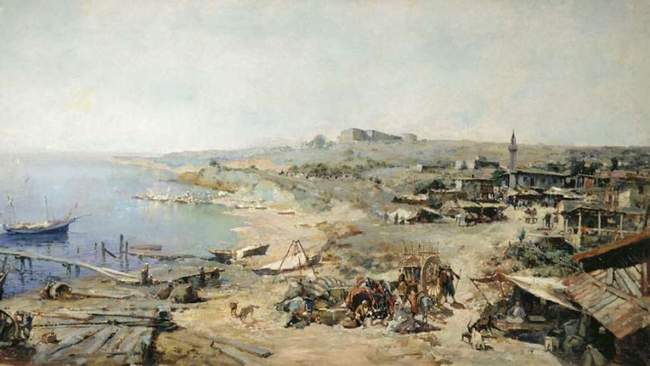Меню
Social networks
Sections
Dec. 23, 2024, 11:46 p.m.
A little-known pearl of Odesa: "Khadzhibey" by Mykola Herbanovsky
Цей матеріал також доступний українською303

Gennady Ladyzhensky. Khadjibey, 1899. Image: Wikipedia
In recent years, the problem of reviving, preserving, and honoring the scientifically based historical heritage of our city has attracted the attention of researchers and the public. The so-called "prehistory of Odesa" is of particular interest in this regard, and while the scientific works of scholars on ancient and medieval history are widely known, the lack of fiction against the background of scientific works is also quite noticeable.
Researchers such as Oleksandr Boldyrev (1963-2001), Anatolii Bachynskyi (1933-1995), Olena Bachynska, Taras Honcharuk, Andrii Krasnazhon, Volodymyr Poltorak, Oleksandr Sereda, and others have made considerable efforts to combat historical myths.
As for works of fiction about the early history of Odesa, the only one that comes to mind is the adventure novel trilogy Khadzhibey by Ukrainian writer Yurii Trusov (1914-1991). Its appearance was a real find for history buffs. Published in 1958-1968, parts of the novel received many favorable reviews from literary critics and underwent several reprints.

The story Hadjibey was written much earlier and published in 1829, making it one of the first literary works about Hadjibey. The existence of the story has been known in academic circles for quite some time. At one time, the Soviet literary critic and folklorist Viktor Zhyrmunsky mentioned Khadjibey in his monograph. Today, the Ukrainian historian and researcher of Hadjibey's past Taras Honcharuk, who has already mentioned it, actively quotes excerpts from the story.
Thanks to the efforts of librarians and digital technologies, anyone interested in the history of Odesa can now look through the pages of the old book. In particular, it can be found in the electronic collection of rare and valuable publications of the nineteenth century of the Scientific Library of the I. I. Mechnikov Odesa National University at the link.
The story is 60 pages long, and the text is divided into 8 chapters and 29 excerpts. Songs and dialogues of the main characters are separate parts of the text. Each chapter opens with an epithet containing quotes from the works of the English poet George Byron, French poets Emile Deschamps, Jean de Lafontaine, and others. However, the Russian poet Yevgeny Baratynskyisalso quoted. The chapters end with small thematic drawings.
The work is an excursion into the era of Ottoman Khadjibey, when our city, along with the southern territories of modern Ukraine, was under the rule of the Muslim empire. The story is based on the love story of a young girl who, in order to save her father, is forced to leave her beloved and live out her life in the harem of the insidious Bey. It is interesting that the sultan's viceroy in the city is named Ji-Bey (where "Bey" is a military rank), the full form of the name is Haji Bey, a kind of anagram to the name of the city. And the name of the main character, Zülemma, is an analog of the name popularized after the story of the famous Roksolana (known in the empire as Hürrem).
The beginning of the story presents us with a picture of the capital city of Istanbul, and then the characters find themselves in the distant and alien to them Khadjibey. The story's denouement is fatal: having met by chance after a long separation, the lovers commit suicide.
From the text of the work, the reader learns a lot of interesting information about important indicators of Khadjibey's life at that time. The story contains evidence of revitalized trade relations with Istanbul, the administrative and social structure of Hadjibey, and introduces the peculiarities of Ottoman traditions and life. In this regard, the author uses several quotations from the Qur'an. The endnotes with explanations of Turkic words, such as bayram, bashlyk, sofa, eunuch, imam, etc., help the reader to better understand the features of the text.
The technical design and bibliographic information of the novel contain information about the period when the author lived, and the city "newly founded" by the imperial authorities was under the control of the Russian Empire. In the nineteenth century, Odesa experienced a period of economic and cultural growth, and the city had its own printing house for a long time, where the story was published in 1838. As a mandatory element, it contains a permit from the local censorship committee, which was introduced during the reign of Nicholas I. The work was signed for publication in 1837.

The book also bears the stamp of the public library. The seal of the library is complemented by the coat of arms of the city, which Odesa received in 1797. But, above the well-known cat anchor is an imperial double-headed eagle, added to the heraldic tradition during the reign of Emperor Alexander I.
The stamp of the public library and the city's coat of arms are absent from the digital version of the book, but are present in the paper version.
The biography of the author of "Khadjibey" was researched by Ukrainian literary critic, bibliographer, and Odesa resident Hryhorii Zlenko. The researcher named Mykola Herbanovskyi, a little-known poet, as the author of the novel. The poet was born in the early nineteenth century in Moldova and was Moldovan by nationality. However, he never wrote in the language of his ancestors and probably did not speak it at all, as total imperial Russification affected Moldova as well as Ukraine.
By 1829, Mykola Herbanovskyi had completed his first significant work of art, which was Khadzhibey. However, the reasons for holding back the novel's publication until 1838 remain unknown.
The reaction of the media of the time was also rather modest. The newspaper Odesskyi Visnyk wrote a short article about it, and that was all. Nevertheless, the young poet's attempts did not go unnoticed by the critic Mykola Nadezhdin, who, while compiling the Odesa Almanac for 1840, invited Mykola Herbanovskyi to publish it. The collaboration presented readers with the poem "Chornooka" ("Black-eyed"). Unlike Vissarion Belinsky, who attributed the publications of Mykola Herbanovskyi and other authors to diversity and shadows, Mykola Nadezhdin wrote favorably about the poet as a phenomenon of Odesa's original origin.
Perhaps Mykola Herbanovskyi owes his only known publication in the capital to the critic, the poem "Imitation of an Arab", which was published in 1845 in the St. Petersburg almanac Meteor, published by the owner of a rather successful publishing company , Matvii Olkhin.
In addition to his writing, Mykola Herbanovskyi was an active contributor to the Odesa Bulletin, collected folklore, on the basis of which he later wrote the drama Ruxanda, the Daughter of the Moldovan Lord Vasyl Lupul, contributed to the birth of the national theater, and worked in the field of public education.
He was one of the Moldovan writers united around the writer and historian Alexandru Ghizdeu, who sought to create a fundamental scientific work on the history of Moldova. However, the grip of Russian imperial ideology prevented the realization of the plan.
According to the research of Moldovan literary historian Ion Osadcenco, Nicolae Herbanovschi died in the 1860s. Unfortunately, the poet's grave has not been preserved.
Оксана Сорокіна











